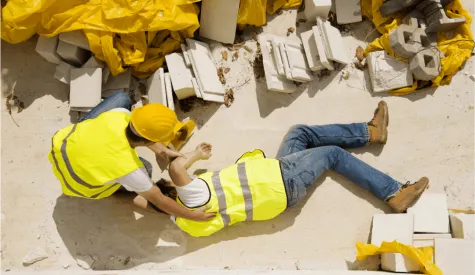Preventing Slips, Trips, and Falls in the Workplace

Each year, a slip, trip, or fall is the cause of roughly 1 in 6 workplace fatalities, in addition to over 200,000 more nonfatal injuries. What kinds of incidents does this category entail? And what can you do in your own workplace to help keep employees safe? Keep reading this short blog post to find out!
Is It a Slip, a Trip, or a Fall?
A slip occurs when there is too little traction between a person’s shoe and the surface they’re walking on. These incidents are more likely when walking surfaces are wet, perhaps from a spill or bad weather, or when workers are in a hurry.
A trip occurs when a person’s foot unexpectedly comes into contact with an object that’s in their path. Rushing while on the job can result in accidental tripping.
A fall occurs when a person’s balance is off. Obviously, a slip or a trip can cause a sudden loss of balance, but so can other behaviors such as leaning too far to one side when on a ladder. Falls can occur either on the same level or when a person falls from one level down to another.
Safety Starts with Good Housekeeping
The easiest way to help employees stay on their feet is for everyone to maintain good housekeeping. Keeping workplaces clean and well organized should be part of every employee’s daily routine.
Here are some tips to keep in mind, no matter what kind of working environment you find yourself in:
- Adopt a “clean as you go” approach. Instead of waiting until the end of the day to pick up after yourself, put tools and equipment away as you finish with them, sweep up as needed, and place scrap and trash in the appropriate containers instead of letting debris accumulate.
- When you notice a slip or trip hazard in your work area, take care of it before anyone gets hurt: An open file cabinet drawer or visible power cord is an accident waiting to happen, so keep an eye out for floor-level dangers that can easily be remedied.
- Clean up spills immediately — don’t assume a coworker is handling it. While the floor is drying, use a “Caution – Wet Floor” sign or a barricade to warn other workers that a slip hazard exists.
- Keep hallways and stairways free of clutter. Don’t store tools, cans, boxes, or other items on the floor where they can be tripped over.
Two Types of Falls and How to Prevent Them
Same-level falls occur when a person falls onto the surface they’re walking on, and elevated falls occur when a person falls to a lower level.
- Always move at a safe pace, giving yourself time to get to your destination without running.
- Never assume anything. A walkway that was free of obstacles 10 minutes ago may not be clear the next time you use it.
- Don’t carry any object that’s large enough to block your vision – instead, find a safer way of moving the object.
- When going up or down stairways, always use the handrail and take the steps one at a time.
- Avoid walking through poorly lit areas. If you must enter an area with insufficient lighting, use a flashlight or other supplemental light, and move about with extra caution.
- Report unsafe conditions, like missing or damaged handrails and burned-out light lighting, to your supervisor.
- Whenever possible avoid stepping onto icy sidewalks, newly mopped floors, or other slippery surfaces.
- If you must walk on a slippery surface, walk more slowly and shorten your stride to keep your center of gravity beneath you for better balance. Point your feet slightly outward as you walk to add stability. When you set your foot down, instead of touching the ground with your heel first, place your entire foot flat on the ground so that it’s less likely to slide out from under you.
Common Office Hazards for Slips, Trips, and Falls
People often believe slipping and falling only occurs in higher-risk industries, such as construction, but a normal office setting has plenty of dangers employees should be aware of.
- Staircases might include irregular steps, poor lightning, or improper handrails
- Parking lots or sidewalks often feature uneven surfaces, such as cracks or potholes, inadequate lightning, or weather hazards like puddles and ice
- Interior walkways may be made of varied materials that can create hazards, such as a rug with corners that do not lay flat
- Uncovered cables for computers, printers, and various other office equipment, can be dangerous for both electrical safety reasons and tripping incidents, so use approved cord covers as needed
Employee Training for Workplace Slips, Trips, and Falls
While any employee can keep an eye out for tripping and falling dangers, remember that employers are responsible for providing a safe work environment.
HSI offers a course on preventing slip, trip and fall injuries, which can help any employee further understand common workplace hazards and how to reduce — or ideally prevent — these injuries from occurring.

